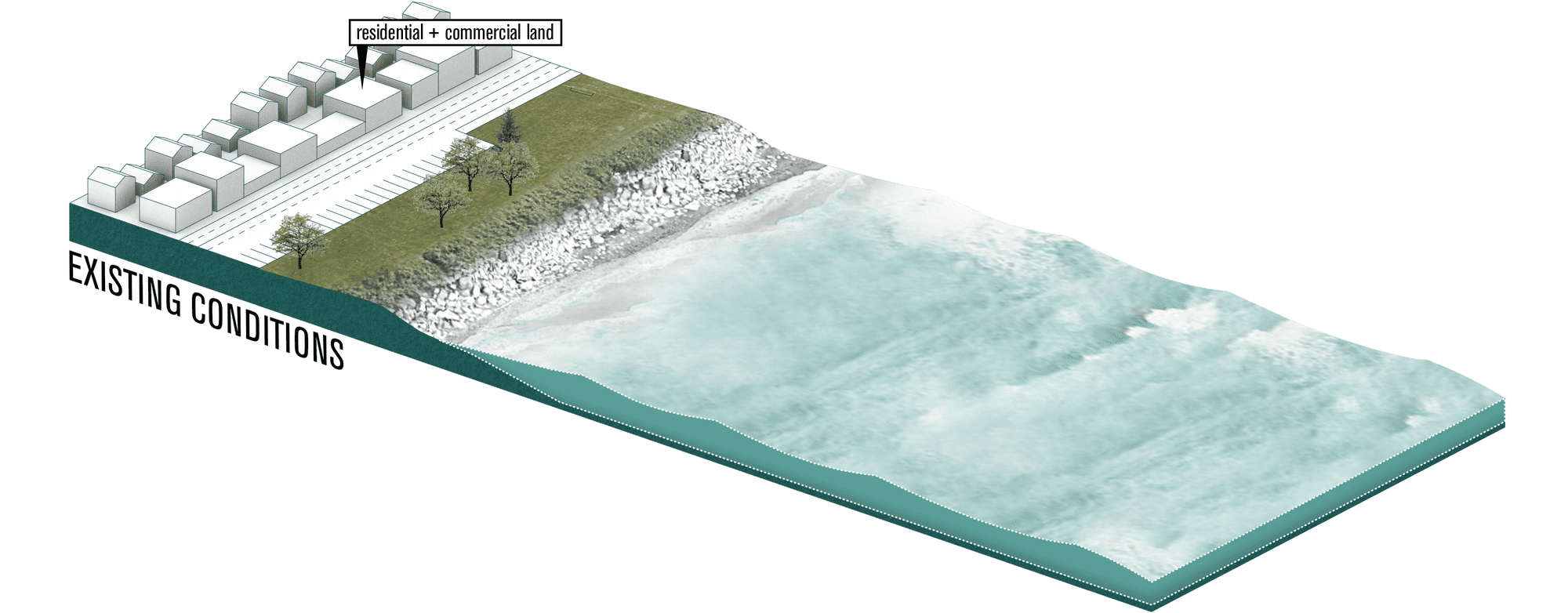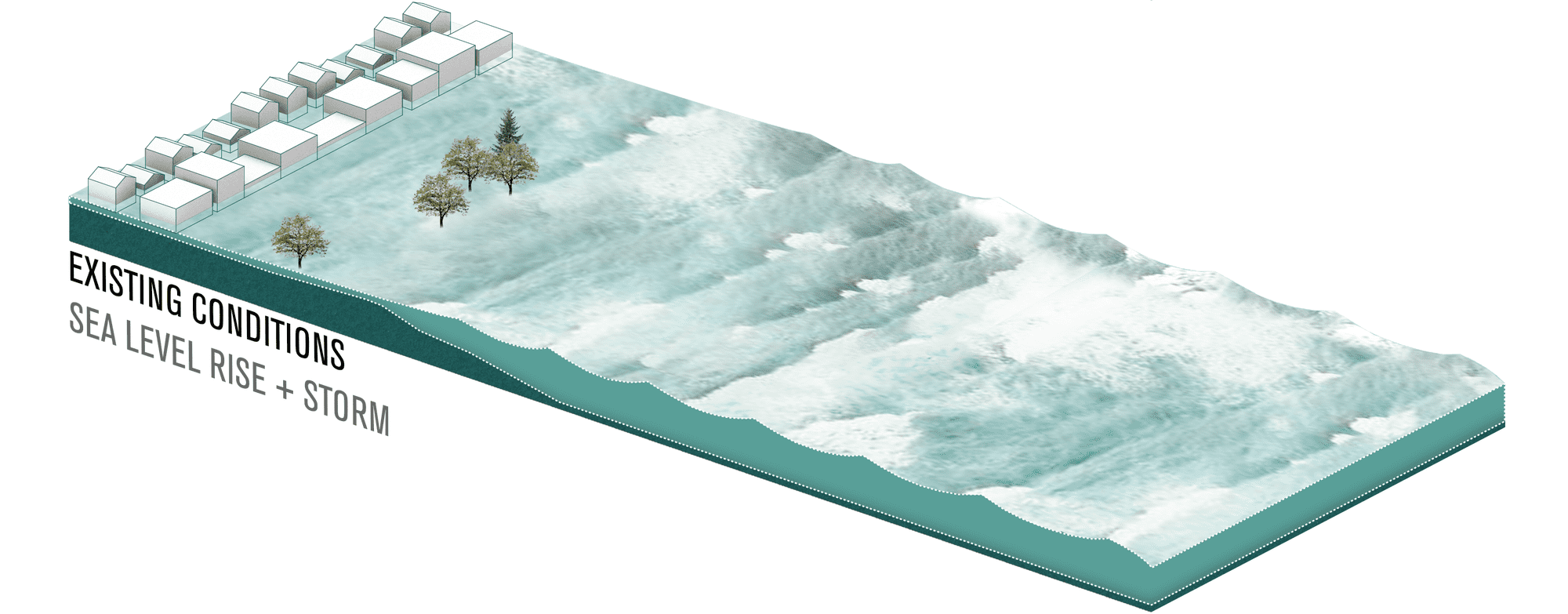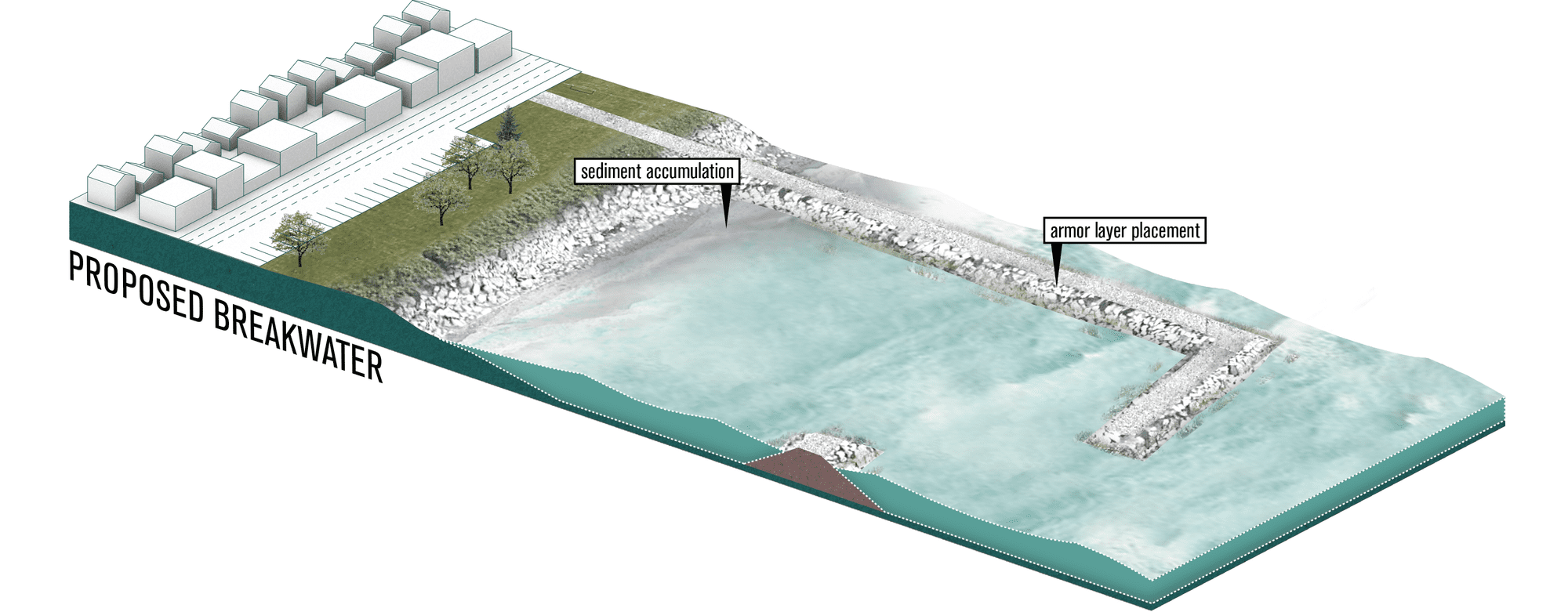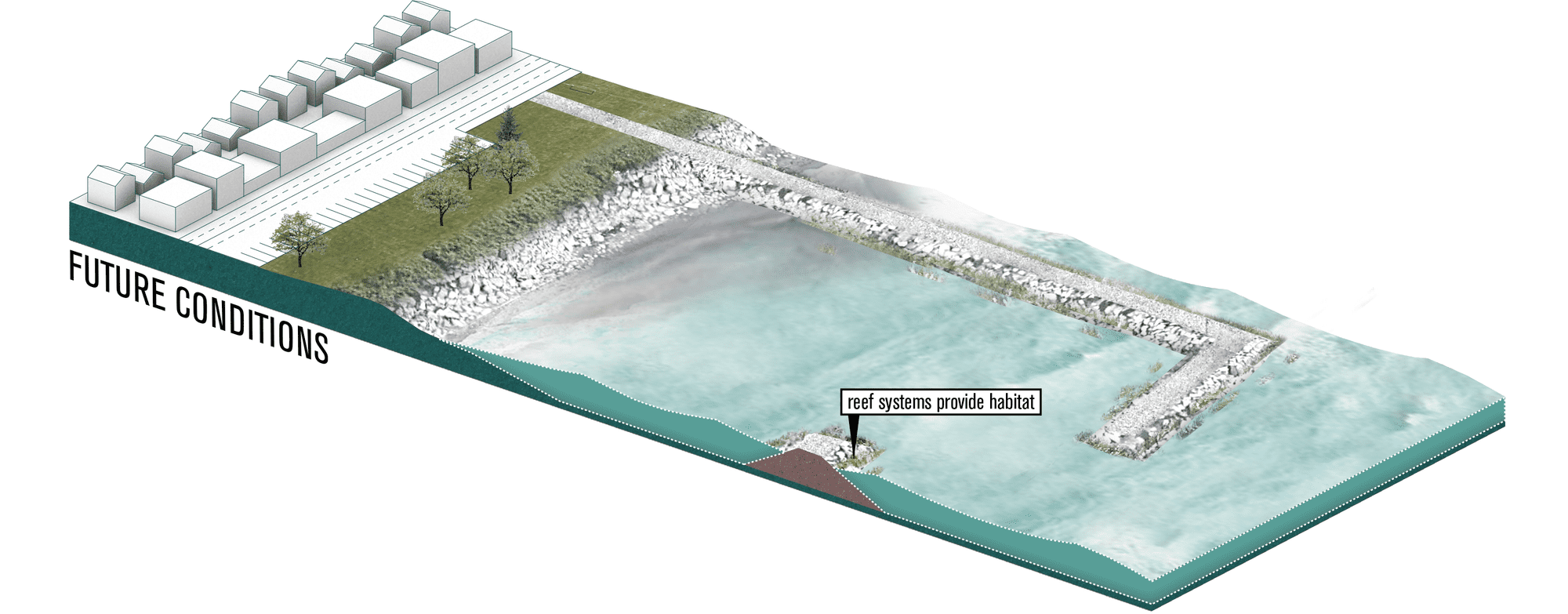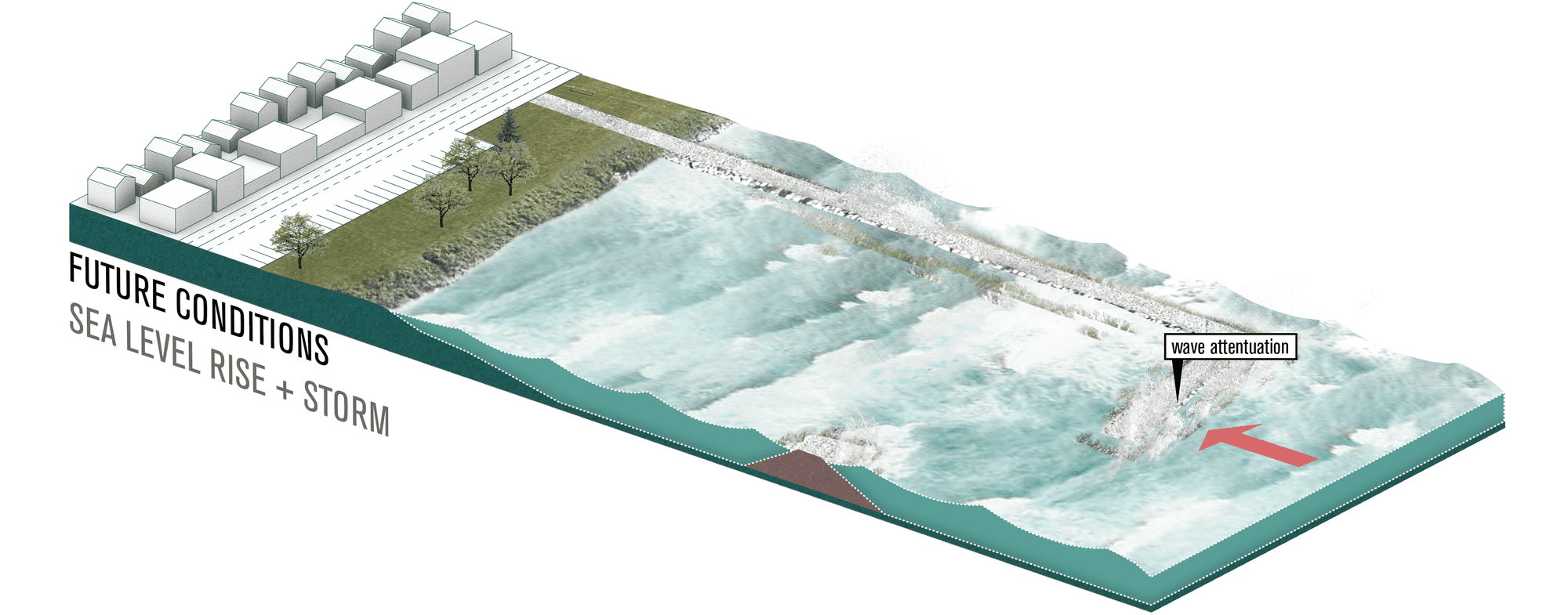Adaptation Strategy: Breakwaters
Breakwaters are linear, offshore, or onshore structures built to protect the coast from the effects of both storm surges and longshore drift. There are many types of breakwaters including emergent, submergent, offshore, or those connected to the shore. A breakwater can be a single continuous structure or several detached structures.1 A breakwater is usually constructed by stacking large rocks or concrete units in a revetment slope.2 Recently, concrete unit designs have been incorporating ecological functions that enhance habitat sustainability. Such designs have used textured patterns that allow reef systems to thrive.
How it works
Types of breakwaters
- Detached breakwater systems are constructed without any direct connection to the shore. These systems are designed to promote sediment deposition on their leeside. They are appropriate in coastlines that are prone to significant sediment transport.
- Headland breakwater systems are constructed as a series of breakwater structures that are attached to the shoreline. Each structure is set at an angle. This helps to break up predominant wave patterns. Behind these structures, the shoreline evolves as a log spiral embayment.
- Nearshore breakwaters are detached systems that are parallel to the shoreline. They are designed to slow down littoral drift but they produce sediment deposition and shoreline bulge.
- Rubble mound breakwaters are constructed using an armor layer, filter layer, and a core. They are built from quarry run rock that is overlaid by large boulders. Wave action is reduced by constructing crown walls at the top of the structure. 14
Benefits
- Provides storm surge protection from coastal erosion by reducing wave action
- Protects coastal infrastructure, e.g., harbors and marinas
- Reduces longshore sediment transport behind the breakwater 14
- Create and support biogenic habitats that support marine life. Biogenic habitats are developed from the activities of one or more organisms. Coldwater corals are widely recognized as a biogenic organism.
Challenges
- Increases erosion on the lee side (north side) of the breakwater which counters the positive effect of accretion behind the breakwater.
- Offshore breakwaters may hinder onshore sediment transport and thereby prevent the rehabilitation of an eroded beach 14
- Depending on the type of system and design requirements, the cost of construction and maintenance may be high 15
- May lead to habitat fragmentation thereby interrupting the migration of marine species
Example projects
Concrete Oyster Reef Rings
Bengal Islands of Kutubdia, Bangladesh 6
The Bangladesh coast has been severely impacted by both land erosion and accretion and has become an active location for innovative coastal eco-engineering practices.6 Since 1966, soft eco-engineering practices have become increasingly popular as a coastal defense against storm surges and sea-level rise.7 One of the successful examples of soft eco-engineering is the construction of 123 concrete oyster reef rings along the coast of Kutubdia. Each concrete unit has thick perforated walls; 0.8 meters high. The diameter of each unit is 0.5 meters. The cost of each unit is about $50.8 The units are combined to form 3 breakwaters each 20m long that function to reduce coastal erosion, encourage salt marsh development, provide sustainable fisheries and attenuate wave action.9
Living Breakwaters
Staten Island NY, USA 5
Living Breakwaters is a Rebuild by Design winning proposal for the design of Staten Island’s south shore. The design concept seeks to reduce risk by building breakwater structures that are ecological resilience. This is achieved using a necklace of offshore breakwaters.3 The design of these unique breakwaters distinguishes them from other breakwater systems. The design also features a mix of sub-tidal beds, forms, and micro-pockets that serve as habitat for different marine species. The breakwaters create a calm environment behind them that promotes water-based activities and land-based activities.4 The project has received $60 million in funding.5
Citations
-
1.
↑
https://www.sciencedirect.com/topics/earth-and-planetary-sciences/breakwater
-
2.
↑
“Breakwater (Structure).” Wikipedia, Wikimedia Foundation, 1 Aug. 2019, https://en.wikipedia.org/wiki/Breakwater_(structure).
-
3.
↑
Ibid.
-
4.
↑
“Living Breakwaters.” Rebuild by Design, http://rebuildbydesign.org/our-work/all-proposals/living-breakwaters.
-
5.
↑
Ibid.
-
6.
↑
“Environmental Review Completed for Living Breakwaters.” Rebuild by Design, http://www.rebuildbydesign.org/news-and-events/updates/environmental-review-completed-for-living-breakwaters.
-
7.
↑
Chowdhury, Mohammed Shah Nawaz. Ecological Engineering with Oysters for Coastal Resilience: Habitat Suitability, Bioenergetics, and Ecosystem Services. pp 15. https://www.wur.nl/upload_mm/6/d/c/7534ff12-d1d1-4088-99de-77a76909ff14_MSNChowdhury_PhD Thesis_2019.pdf.
-
8.
↑
Ibid, 19.
-
9.
↑
Ibid, 21.
-
10.
↑
Ibid, 21.
-
11.
↑
Submerged break water, https://www.sciencedirect.com/topics/engineering/submerged-breakwater
-
12.
↑
Firth, L. B., Mieszkowska, N., Thompson, R. C., & Hawkins, S. J. (2013). Climate change and adaptational impacts in coastal systems: the case of sea defences. Environmental Science: Processes & Impacts, 15(9), 1665-1670.
-
13.
↑
Living Breakwater, http://www.rebuildbydesign.org/our-work/all-proposals/winning-projects/ny-living-breakwaters
-
14.
↑
Pluijm, M, et al., 1994. Offshore breakwaters versus beach nourishments, a comparison, p. 3208-3222. 24th ICCE, Kobe, Japan
-
15.
↑
Hauer, M., Op den Velde, W., Vrijling, J. K., & d'Angremond, K. (1995). Comparison construction costs conventional rubblemound breakwaters/bermbreakwater.
-
i1.
↑
SCAPE. Rendering of Living Breakwaters. https://www.scapestudio.com/wp-content/uploads/2018/06/180613_LB.jpg.
-
i2.
↑
WUR. Oysters Have Settled on Concrete Rings Placed on the Coast of the Bengal Island of Kutubdia to Form an Oyster Breakwater Reef That Stops Erosion. https://www.dutchwatersector.com/sites/default/files/styles/content_m_x2/public/2019-07/wur oyster reefs photo 02.jpg?h=32029293&itok=fd4HueGm.
-
i3.
↑
Oyster reefs used to counter large waves https://www.wur.nl/en/Research-Results/Research-Institutes/marine-research/show-marine/Oyster-reefs-used-to-counter-large-waves.htm
-
i4.
↑
Figure 1. Maritime. (2017). Completion of breakwaters for Portarlington harbour redevelopment project. https://www.awmaritime.com/completion-of-breakwaters-for-portarlington-harbour-redevelopment-project/
-
i5.
↑
Figure 2. Rebuild by design. Living breakwater south shore Staten Island. http://www.rebuildbydesign.org/our-work/all-proposals/winning-projects/ny-living-breakwaters
-
i6.
↑
Figure 3. Wageningen University and Research. (2018). Oyster reefs used to counter large waves. https://www.wur.nl/en/Research-Results/Research-Institutes/marine-research/show-marine/Oyster-reefs-used-to-counter-large-waves.htm
